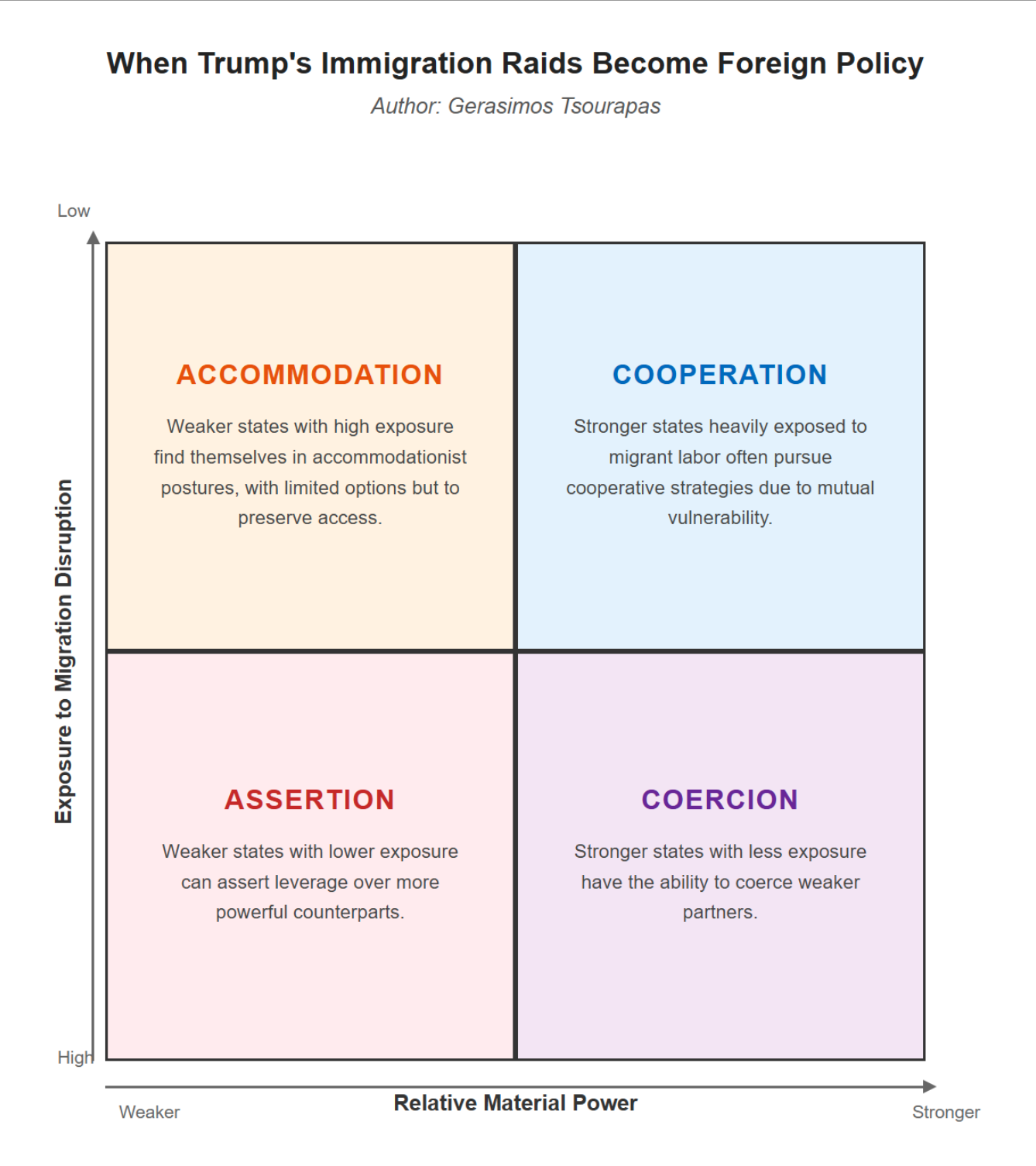When Trump’s immigration raids become foreign policy – Niskanen Center

Report on Migration Interdependence and its Implications for Sustainable Development Goals
1.0 Introduction: The Hyundai-LG Plant Incident
In September 2025, a major U.S. immigration enforcement action at a Hyundai-LG electric vehicle battery plant in Georgia resulted in the detention of nearly 500 workers, including over 300 South Korean nationals. This event, occurring shortly after a U.S.-South Korea summit focused on new investment, highlighted a critical tension between domestic policy and international partnerships. The incident underscores the concept of “migration interdependence,” where cross-border labor mobility creates complex political and economic dependencies that directly impact the achievement of the Sustainable Development Goals (SDGs), particularly SDG 8 (Decent Work and Economic Growth), SDG 10 (Reduced Inequalities), and SDG 17 (Partnerships for the Goals).
2.0 Migration Interdependence: A Framework for Analysis
Migration interdependence refers to the reciprocal, yet often asymmetrical, consequences arising from cross-border labor mobility. The balance of power in these relationships is determined by two key factors:
- Relative Material Power: The economic, institutional, and diplomatic strength of the states involved.
- Exposure: The degree to which a state would suffer costs if migration flows were disrupted.
This framework reveals four configurations that influence state behavior and progress toward the SDGs.
2.1 Cooperative Strategies for Mutual Benefit
When a stronger state is highly exposed to migrant labor, cooperative strategies tend to emerge, fostering progress on SDG 17 (Partnerships for the Goals). The relationship between New Zealand and Pacific Island states exemplifies this. New Zealand’s dependence on seasonal workers for key industries incentivizes stable, institutionalized frameworks like the Recognised Seasonal Employer scheme. This approach supports SDG 8 (Decent Work and Economic Growth) by providing employment and facilitating remittances, which in turn helps advance SDG 10 (Reduced Inequalities) in the workers’ home countries.
2.2 Coercive Actions Undermining Global Partnerships
When a stronger state is less exposed, it may employ coercive tactics that undermine international cooperation. Russia’s use of migration as leverage against remittance-dependent Central Asian states is a prime example. Similarly, the U.S. raid on the Hyundai-LG plant demonstrates how a materially stronger, less exposed state can take actions with significant negative consequences for a partner nation. Such actions conflict with the principles of SDG 16 (Peace, Justice and Strong Institutions) and SDG 17 (Partnerships for the Goals) by creating diplomatic friction and instability.
2.3 Constrained Accommodation and Development Challenges
Weaker states that are highly exposed to migration disruption often adopt accommodationist postures, which can hinder development. Nepal’s relationship with the Gulf Cooperation Council (GCC) states illustrates this dynamic. With remittances constituting a quarter of its GDP, Nepal has limited leverage to demand better conditions for its workers, posing a significant challenge to achieving SDG 8 (Decent Work and Economic Growth) and protecting migrant rights as outlined in SDG 10 (Reduced Inequalities).
2.4 Asserting Leverage for Worker Protections
Conversely, a weaker state with lower exposure can assert leverage to advance development goals. Indonesia’s relationship with Malaysia shows how a diversified migration portfolio can empower a labor-sending country. By imposing moratoria on sending workers, Indonesia has successfully pressed for stronger protections, directly contributing to the objectives of SDG 8 by ensuring safer and more secure working environments for its migrant citizens.
3.0 U.S. Policy Contradictions and SDG Alignment
Current U.S. policy exhibits a significant contradiction that impedes sustainable development. On one hand, the government actively promotes foreign direct investment in strategic sectors like renewable energy and advanced manufacturing, aligning with SDG 9 (Industry, Innovation and Infrastructure). On the other hand, aggressive and unpredictable immigration enforcement actions, such as the Hyundai raid, create instability for the very firms and skilled workers needed to realize these industrial goals. This policy incoherence undermines the trust required for SDG 17 (Partnerships for the Goals) and disrupts progress on SDG 8 by creating precarious work conditions.
4.0 Policy Recommendations for Coherence in Sustainable Development
To align migration policy with broader economic and geopolitical goals, and to advance the 2030 Agenda for Sustainable Development, the following actions are recommended:
- Create Predictable Mobility Channels: Establish and expand visa categories for technical specialists and workers tied to major foreign investment projects. This will support SDG 9 by ensuring industrial projects have the necessary expertise, while promoting SDG 8 through stable employment.
- Institutionalize Bilateral Frameworks: Move from discretionary enforcement to structured agreements with key partner nations. Such frameworks are a core component of SDG 17, allowing for the orderly management of labor mobility and dispute resolution.
- Integrate Migration into Foreign Policy Planning: Systematically assess migration interdependence as a strategic variable, similar to energy or trade dependence. This enhances the capacity of institutions to create coherent policy, a key target of SDG 16.
- Calibrate Enforcement with Strategic Goals: Ensure immigration enforcement actions consider their impact on foreign policy, industrial strategy, and alliance management. This approach embodies the principle of Policy Coherence for Sustainable Development, essential for achieving the interconnected goals of the 2030 Agenda.
Analysis of Sustainable Development Goals in the Article
1. Which SDGs are addressed or connected to the issues highlighted in the article?
- SDG 8: Decent Work and Economic Growth – The article focuses on labor mobility, the rights and conditions of migrant workers, and their contribution to critical economic sectors like manufacturing, agriculture, and technology.
- SDG 9: Industry, Innovation and Infrastructure – The context of the article is heavily tied to industrial policy, specifically the development of advanced manufacturing facilities like the Hyundai–LG electric vehicle battery plant, which requires foreign direct investment and specialized labor.
- SDG 10: Reduced Inequalities – The article’s central theme of “migration interdependence” directly relates to managing international migration. It discusses remittances, the power dynamics between countries, and the need for well-managed migration policies.
- SDG 17: Partnerships for the Goals – The analysis revolves around bilateral and international relations shaped by labor mobility. It highlights the need for policy coherence and institutionalized cooperation between countries to manage migration effectively and avoid diplomatic crises.
2. What specific targets under those SDGs can be identified based on the article’s content?
- Under SDG 8: Decent Work and Economic Growth
- Target 8.8: Protect labor rights and promote safe and secure working environments for all workers, including migrant workers. This is evident in the discussion of Indonesia imposing moratoria on sending workers to Malaysia “to press for stronger protections for its citizens” and the mention of abuse reports concerning Nepalese workers in the Gulf.
- Under SDG 9: Industry, Innovation and Infrastructure
- Target 9.2: Promote inclusive and sustainable industrialization. The article highlights the U.S. administration “courting foreign direct investment in semiconductor fabrication, electric vehicle batteries, and advanced manufacturing” as part of a “large-scale domestic industrial renewal,” which directly links to this target.
- Under SDG 10: Reduced Inequalities
- Target 10.7: Facilitate orderly, safe, regular and responsible migration and mobility of people, including through the implementation of planned and well-managed migration policies. The entire article critiques the lack of such policies, citing the Hyundai raid as a failure of coordination. It recommends creating “predictable mobility channels” and “institutionalized bilateral frameworks” to manage labor flows.
- Target 10.c: Reduce to less than 3 percent the transaction costs of migrant remittances. The article emphasizes the economic dependence of certain countries on remittances, stating they “constitute a quarter of Nepal’s GDP” and that Tajikistan, Kyrgyzstan, and Uzbekistan are “among the most remittance-dependent economies in the world,” making the cost and flow of these funds a relevant issue.
- Under SDG 17: Partnerships for the Goals
- Target 17.14: Enhance policy coherence for sustainable development. The article’s central argument is about the “contradictions of U.S. policy,” where “aggressive immigration enforcement creates uncertainty for precisely the firms and workers being asked to deliver” on industrial policy goals. It explicitly calls for aligning “industrial and immigration policy.”
3. Are there any indicators mentioned or implied in the article that can be used to measure progress towards the identified targets?
- Existence of Bilateral Labor Agreements: The recommendation to move toward “institutionalized bilateral frameworks with key partners” implies that the number and quality of such agreements can be an indicator for Target 10.7. The article mentions New Zealand’s “Recognised Seasonal Employer scheme” as a positive example of an institutional framework.
- Remittances as a Percentage of GDP: The article explicitly states that “remittances constitute a quarter of Nepal’s GDP.” This metric is a direct indicator for measuring the economic impact of migration and the importance of Target 10.c for remittance-dependent countries.
- Volume of Foreign Direct Investment (FDI) in Key Sectors: The mention of South Korea pledging “billions of dollars in new U.S. investment” and the focus on “semiconductor fabrication, electric vehicle batteries, and advanced manufacturing” suggest that FDI flows into these industrial sectors are a key indicator for Target 9.2.
- Number of Migrant Worker Detentions or Deportations: The raid on the Hyundai plant, where “agents detained nearly 500 workers,” serves as a negative indicator. A reduction in such large-scale enforcement actions that create diplomatic friction could measure progress toward more coherent and well-managed migration policies under Targets 10.7 and 17.14.
- Inclusion of Worker Protections in Agreements: Indonesia’s use of moratoria “to press for stronger protections for its citizens” implies that the presence and enforcement of clauses related to worker rights in bilateral agreements is a measurable indicator for Target 8.8.
4. Table of SDGs, Targets, and Indicators
| SDGs | Targets | Indicators |
|---|---|---|
| SDG 8: Decent Work and Economic Growth | 8.8: Protect labor rights and promote safe and secure working environments for all workers, including migrant workers. | Number and enforcement of bilateral agreements that include specific clauses for migrant worker protection. |
| SDG 9: Industry, Innovation and Infrastructure | 9.2: Promote inclusive and sustainable industrialization. | Volume of foreign direct investment in key manufacturing sectors (e.g., EV batteries, semiconductors). |
| SDG 10: Reduced Inequalities | 10.7: Facilitate orderly, safe, regular and responsible migration and mobility of people. | Existence of institutionalized bilateral frameworks and predictable visa channels; number of workers affected by sudden enforcement actions. |
| 10.c: Reduce the transaction costs of migrant remittances. | Volume of remittances as a percentage of a country’s GDP. | |
| SDG 17: Partnerships for the Goals | 17.14: Enhance policy coherence for sustainable development. | Alignment of immigration enforcement priorities with industrial strategy and foreign policy goals. |
Source: niskanencenter.org
What is Your Reaction?
 Like
0
Like
0
 Dislike
0
Dislike
0
 Love
0
Love
0
 Funny
0
Funny
0
 Angry
0
Angry
0
 Sad
0
Sad
0
 Wow
0
Wow
0
















































:focal(1500,1000)/https://media.globalcitizen.org/a6/9a/a69a4720-d8a1-4715-b596-18738d03c05c/rotary_polio_hero_image.jpg?#)







/countries/sri-lanka/photo-credit---dmc-sri-lanka.tmb-1200v.jpg?sfvrsn=dc298bcc_1#)


















